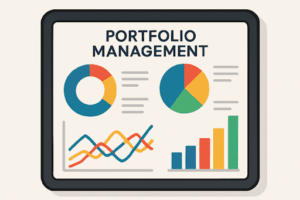Table of Contents
- The Rise of Technology in Portfolio Management
- Balancing Risk and Reward
- Transparent Client Communication
- Data-Driven Decision Making
- Integrating Sustainable Investment Principles
- Automation and Human Advice: Working Together
- Adapting to Industry Trends
- The Future Outlook
The Rise of Technology in Portfolio Management
Modern portfolio management has undergone a seismic shift in recent years, spurred largely by advances in technology. Legacy paper-based and sophisticated software systems, intuitive dashboards, and integrated analytics have replaced spreadsheet-driven approaches. Platforms such as ridgelineapps.com are at the forefront of this transformation, equipping portfolio managers with the tools to analyze complex portfolios, automate processes, and monitor risk seamlessly. By utilizing cloud-based solutions and centralized data flows, today’s professionals can make informed decisions faster and more accurately than ever before.
These digital innovations allow investment teams to collaborate in real-time, implement robust compliance protocols, and serve clients with tailored insights. According to a comprehensive Morgan Stanley analysis, the integration of artificial intelligence (AI), automation, and big data has transitioned portfolio management from an art to a science. Tools powered by AI optimize everything from allocation to risk management, unlocking new efficiencies while opening the door for more diverse client strategies.
Balancing Risk and Reward
The quest for the ideal balance between risk and reward remains a cornerstone of portfolio strategy. Modern approaches move beyond conventional stock-bond allocations by supplementing them with alternative assets such as real estate, commodities, and digital currencies. The core-satellite investment methodology is increasingly popular: a broad, diversified “core” serves as a portfolio’s stable foundation, while “satellite” investments pursue growth and alpha. This approach not only provides a buffer against market turbulence but also leverages timely opportunities in emerging sectors.
Continual monitoring and dynamic rebalancing are also central to managing risk and return in today’s markets. Advanced analytics and scenario modeling allow managers to test their assumptions and align risk levels with clients’ financial objectives and evolving tolerance. Ultimately, the ability to course-correct in response to shifting dynamics ensures a client-centric approach to delivering stable, long-term growth.
Transparent Client Communication
Transparency is no longer negotiable—it’s an expectation. Clients demand clear, timely updates and insight into both portfolio construction and performance. The widespread adoption of client portals and visual dashboards has narrowed the information gap and enabled more interactive, two-way communication. In turn, this heightened transparency fosters trust, accountability, and a better understanding of investment outcomes.
A recent Morningstar article highlights how technology empowers clients to engage with their investments and advisors proactively, receiving real-time notifications, scenario analysis, and performance reporting—all critical to modern client relationships. Regular, jargon-free updates build rapport and empower clients, leading to more informed and confident investment decisions.

Data-Driven Decision Making
The explosion of available data is reshaping how portfolios are constructed and managed. Reliance on reliable metrics, big data, predictive analytics, and machine learning enables managers to move beyond instinct and lean on quantifiable evidence. With these tools, it is possible to forecast performance, identify market inefficiencies, and test portfolio resilience under a variety of hypothetical scenarios.
Importantly, sophisticated data analysis doesn’t remove the need for human judgment but augments it. By providing a factual basis for decisions, it supports both strategic planning and tactical execution. Data-driven insights play a crucial role in tailoring portfolios to client goals, be they aggressive growth or capital preservation.
Integrating Sustainable Investment Principles
Sustainable and responsible investing, aligned with ESG (Environmental, Social, Governance) principles, is now a fixture of mainstream portfolio management. Both institutional and individual investors are increasingly seeking to align their financial goals with broader social and environmental values. Managers integrate ESG ratings, green bonds, and socially conscious funds into client portfolios, balancing the pursuit of returns with the desire for a measurable positive impact on society.
Major market players are recognizing the growing demand for sustainable options. According to CNBC, ESG investments are seeing record inflows as both mandates and market forces push for responsible stewardship. Robust ESG frameworks now feature in investment policy statements, signaling a permanent shift in client expectations and industry standards.
Automation and Human Advice: Working Together
Automation has made portfolio management processes more efficient and affordable, with robo-advisors and algorithmic rebalancing handling many routine tasks. Automated solutions can harvest tax losses, rebalance portfolios, and track performance around the clock. However, the importance of the human advisor remains undiminished—complex client needs, nuanced scenarios, and emotional counsel all require human judgment.
The most effective approach is hybrid: people and machines each contribute their unique strengths. Advisors use automation as a foundation upon which to build personalized strategies, offering empathy, context, and adaptive expertise that technology alone cannot replicate. This collaboration ultimately ensures resilience and long-term success for clients.
Adapting to Industry Trends
Portfolio management is an ever-evolving practice, shaped by regulatory changes, fintech developments, and shifting investor priorities. Savvy professionals embrace continual learning, invest in leading-edge technology, and adapt their practices in step with market and regulatory realities. The unprecedented challenges posed by the COVID-19 pandemic—such as the sudden transition to remote advisory—have highlighted the industry’s capacity for rapid change when client service is at stake.
Ongoing professional development and flexibility ensure that portfolio managers remain prepared to navigate disruption, seize unique opportunities, and maintain their competitive edge in a rapidly
changing landscape.
The Future Outlook
The future of portfolio management is poised to blend agile innovation with timeless principles of client-centric service. As artificial intelligence matures and data becomes ever more abundant, forward-thinking managers will combine technological savvy with holistic client engagement. The continued rise of sustainable investing, transparent communication, and the hybridization of automation and personalized advice will define the profession’s next chapter.
Adaptability, lifelong learning, and a commitment to serving clients’ ambitions will ensure that portfolio management remains a vital discipline—equipping investors to thrive amid whatever challenges and opportunities the markets may present.



